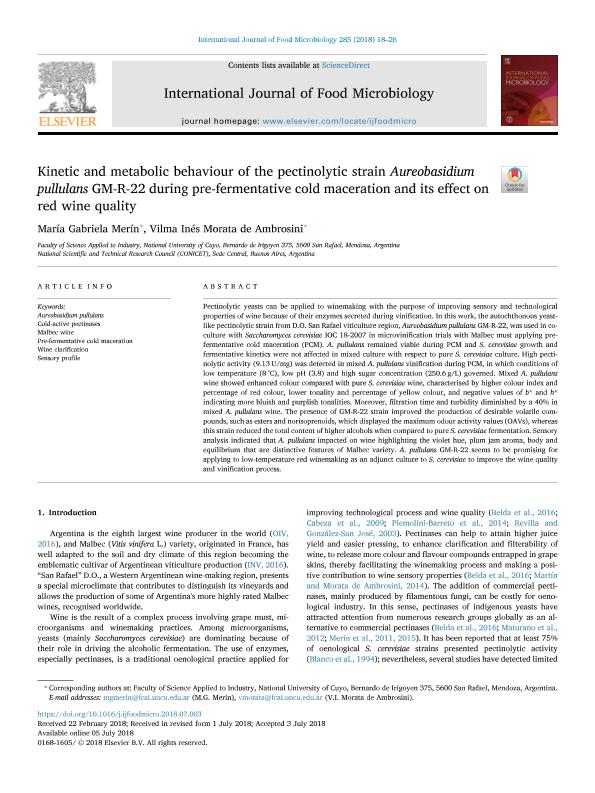Mostrar el registro sencillo del ítem
dc.contributor.author
Merín, María Gabriela

dc.contributor.author
Morata de Ambrosini, Vilma Inés
dc.date.available
2020-03-20T16:08:10Z
dc.date.issued
2018-11
dc.identifier.citation
Merín, María Gabriela; Morata de Ambrosini, Vilma Inés; Kinetic and metabolic behaviour of the pectinolytic strain Aureobasidium pullulans GM-R-22 during pre-fermentative cold maceration and its effect on red wine quality; Elsevier Science; International Journal of Food Microbiology; 285; 11-2018; 18-26
dc.identifier.issn
0168-1605
dc.identifier.uri
http://hdl.handle.net/11336/100400
dc.description.abstract
Pectinolytic yeasts can be applied to winemaking with the purpose of improving sensory and technological properties of wine because of their enzymes secreted during vinification. In this work, the autochthonous yeast-like pectinolytic strain from D.O. San Rafael viticulture region, Aureobasidium pullulans GM-R-22, was used in co-culture with Saccharomyces cerevisiae IOC 18-2007 in microvinification trials with Malbec must applying pre-fermentative cold maceration (PCM). A. pullulans remained viable during PCM and S. cerevisiae growth and fermentative kinetics were not affected in mixed culture with respect to pure S. cerevisiae culture. High pectinolytic activity (9.13 U/mg) was detected in mixed A. pullulans vinification during PCM, in which conditions of low temperature (8 °C), low pH (3.8) and high sugar concentration (250.6 g/L) governed. Mixed A. pullulans wine showed enhanced colour compared with pure S. cerevisiae wine, characterised by higher colour index and percentage of red colour, lower tonality and percentage of yellow colour, and negative values of b* and h* indicating more bluish and purplish tonalities. Moreover, filtration time and turbidity diminished by a 40% in mixed A. pullulans wine. The presence of GM-R-22 strain improved the production of desirable volatile compounds, such as esters and norisoprenoids, which displayed the maximum odour activity values (OAVs), whereas this strain reduced the total content of higher alcohols when compared to pure S. cerevisiae fermentation. Sensory analysis indicated that A. pullulans impacted on wine highlighting the violet hue, plum jam aroma, body and equilibrium that are distinctive features of Malbec variety. A. pullulans GM-R-22 seems to be promising for applying to low-temperature red winemaking as an adjunct culture to S. cerevisiae to improve the wine quality and vinification process.
dc.format
application/pdf
dc.language.iso
eng
dc.publisher
Elsevier Science

dc.rights
info:eu-repo/semantics/openAccess
dc.rights.uri
https://creativecommons.org/licenses/by-nc-sa/2.5/ar/
dc.subject
AUREOBASIDIUM PULLULANS
dc.subject
COLD-ACTIVE PECTINASES
dc.subject
MALBEC WINE
dc.subject
PRE-FERMENTATIVE COLD MACERATION
dc.subject
SENSORY PROFILE
dc.subject
WINE CLARIFICATION
dc.subject.classification
Bioprocesamiento Tecnológico, Biocatálisis, Fermentación

dc.subject.classification
Biotecnología Industrial

dc.subject.classification
INGENIERÍAS Y TECNOLOGÍAS

dc.title
Kinetic and metabolic behaviour of the pectinolytic strain Aureobasidium pullulans GM-R-22 during pre-fermentative cold maceration and its effect on red wine quality
dc.type
info:eu-repo/semantics/article
dc.type
info:ar-repo/semantics/artículo
dc.type
info:eu-repo/semantics/publishedVersion
dc.date.updated
2020-03-20T13:13:21Z
dc.journal.volume
285
dc.journal.pagination
18-26
dc.journal.pais
Países Bajos

dc.journal.ciudad
Amsterdam
dc.description.fil
Fil: Merín, María Gabriela. Universidad Nacional de Cuyo. Facultad de Ciencias Aplicadas a la Industria; Argentina. Consejo Nacional de Investigaciones Científicas y Técnicas. Centro Científico Tecnológico Conicet - Mendoza; Argentina
dc.description.fil
Fil: Morata de Ambrosini, Vilma Inés. Universidad Nacional de Cuyo. Facultad de Ciencias Aplicadas a la Industria; Argentina
dc.journal.title
International Journal of Food Microbiology

dc.relation.alternativeid
info:eu-repo/semantics/altIdentifier/url/https://linkinghub.elsevier.com/retrieve/pii/S0168160518303441
dc.relation.alternativeid
info:eu-repo/semantics/altIdentifier/doi/http://dx.doi.org/10.1016/j.ijfoodmicro.2018.07.003
Archivos asociados
